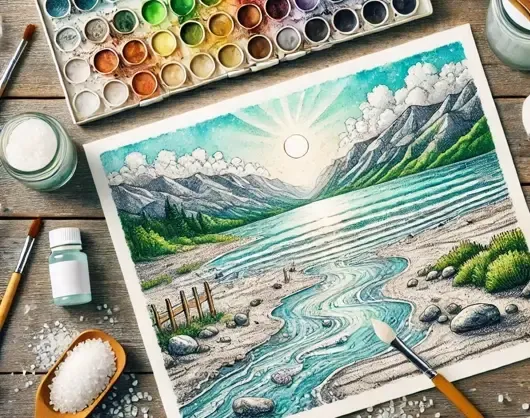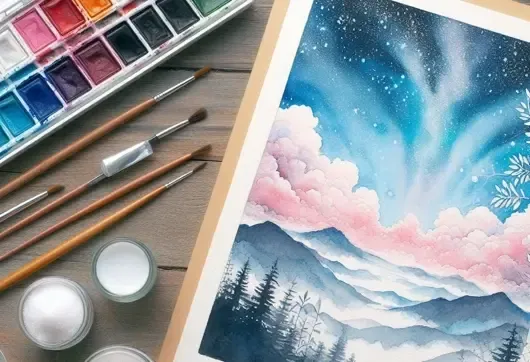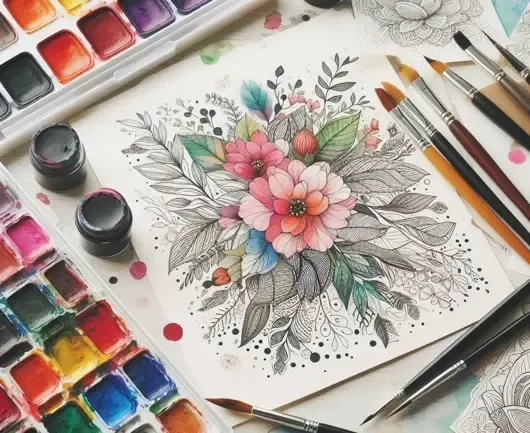Using Watercolors for Coloring Pages
Bring Your Coloring Pages to Life with Watercolor Magic
Introduction
Watercolors are a versatile and vibrant medium that can transform your coloring pages into dynamic works of art. Unlike traditional tools like colored pencils or markers, watercolors offer unique textures and gradients that create a soft, ethereal effect.
However, using watercolors for coloring pages requires some adjustments and techniques to achieve the best results. Here’s a guide to get started.
1. Choosing the Right Paper
Not all coloring pages are designed to handle watercolors. Regular paper can warp or tear when exposed to water, so it's essential to use thick, high-quality paper like watercolor paper or cardstock.
If you’re using a pre-printed coloring page, consider transferring the design to watercolor paper using a lightbox or tracing method.
Alternatively, if you have basic image editing skills using tools like Krita, GIMP, or Inkscape, you can scan the original coloring page, edit it digitally, and print it onto watercolor paper.
When choosing this method, ensure your printer uses ink that won't smear when wet, such as pigment-based ink rather than dye-based ink, as the latter is more prone to running with water exposure.
For those who prefer transferring the design manually, you don’t need to copy the entire design onto the watercolor paper, especially for larger illustrations. Instead, select a section of the artwork to trace and paint.
This allows you to focus on a smaller, more manageable area while experimenting with your watercolor techniques.
2. Gathering Your Supplies
You’ll need the following tools:
- Watercolors: Choose between pans, tubes, or liquid watercolors depending on your preference.
- Brushes: A variety of brushes (round, flat, and detail brushes) will allow you to create different effects.
- Palette: For mixing colors.
- Water: Two jars—one for cleaning brushes and one for fresh water.
- Paper Towel: To control the water on your brush and clean up mistakes.
3. Preparing Your Workspace
Before you begin, tape down the edges of your coloring page to a flat surface. This helps prevent the paper from warping as it dries. Ensure your workspace is well-lit and spacious enough to hold your tools.
4. Basic Techniques for Watercolor Coloring
- Wet-on-Dry: Apply wet watercolor paint to dry paper for precise details. This method is ideal for filling small sections of your coloring page.
- Wet-on-Wet: Apply water to the paper first, then add watercolor. This creates soft gradients and blended effects, perfect for backgrounds or floral designs.
- Layering: Start with light washes and gradually build up darker tones. Watercolors are transparent, so layering allows for depth and richness without overpowering the paper.
5. Adding Texture and Detail
- Dry Brush: Use a brush with minimal water to create textured effects like grass or petals.
- Salt Effect: Sprinkle salt on wet paint to create organic, starburst-like textures.
- Lifting: Use a clean, damp brush or paper towel to lift paint from the paper, creating highlights or correcting mistakes.
6. Preserving White Areas
One of the unique characteristics of watercolors is their transparency, which means there’s no white pigment in the paint itself. This can be both a challenge and an opportunity when working on coloring pages. To create highlights, reflections, or light effects, it's essential to preserve certain areas of the paper as pure white.
6.1. Leaving Areas Unpainted
The simplest way to preserve white areas is by leaving them untouched while painting. When you approach your coloring page, identify the spots where you want the lightest values, such as the brightest highlights or areas that should appear to catch the light. By consciously avoiding these areas, you maintain the paper’s natural white and allow the surrounding colors to contrast more sharply.
6.2. Using Masking Fluid
For more precise control, especially in detailed designs, masking fluid is an invaluable tool. Masking fluid is a liquid rubber that you can apply to areas of the paper you want to protect from paint. Once applied, it dries quickly and forms a protective barrier that resists watercolor. After you finish painting the surrounding areas and the paint has dried, you can simply rub off the masking fluid to reveal the untouched white paper beneath. This technique is perfect for creating fine details, such as the edges of leaves, delicate floral highlights, or the reflective sheen on a surface.
6.3. Alternative Methods for Preserving White Areas
Another technique involves using frisket film, which can be cut into shapes and adhered to the paper. It functions similarly to masking fluid but offers a cleaner and more precise application for complex designs.
6.4. Creating Light Effects
Preserving white areas doesn’t just have to be for highlights. You can use this technique to enhance the overall composition of your artwork. For example, by leaving the center of a flower or a sparkle in a water droplet white, you create a natural light source that draws the viewer's attention and adds dimension to your coloring page.
By carefully preserving white areas, you can simulate realistic lighting effects and add extra depth to your watercolor artwork, resulting in a more dynamic and professional-looking piece.
7. Combining Watercolors with Other Media
Watercolors are incredibly versatile and can be beautifully complemented by other artistic mediums to create depth, detail, and unique effects in your coloring pages. Mixing media opens up endless possibilities for artistic expression while enhancing the overall impact of your artwork. Here are some ways to combine watercolors with other tools:
7.1. Outlining with Fine Liners or Gel Pens
Once the watercolor layer has dried, use fine liners or gel pens to add outlines or intricate details. Black fine liners can create bold, clean edges, giving your work a polished, illustrative style. On the other hand, metallic or white gel pens can be used for highlights or decorative elements, such as stars, dots, or textural accents.
Pro Tip: Test your pen on a scrap piece of paper before applying it to ensure it works smoothly over the watercolor surface.
7.2. Enhancing with Colored Pencils
Colored pencils work wonderfully over watercolor layers to add definition, shading, or vibrant details. Watercolor provides a soft, blended base, while colored pencils can refine edges or intensify colors where needed. They are especially effective for enhancing shadows, creating textures, or adding small, precise elements.
Pro Tip: Use soft pencils, such as Prismacolor or Polychromos, for smooth application without scratching the watercolor layer.
7.3. Accents with Pastels
Soft pastels or pastel pencils can be used to create soft highlights or gradients on top of watercolor. Their subtle opacity contrasts nicely with the translucency of watercolor, allowing you to achieve a dreamy effect. Seal the pastels with a fixative spray to prevent smudging.
7.4. Textural Effects with Ink or Markers
Inks or alcohol-based markers can be used to layer bold patterns or intricate designs on top of watercolor. Use waterproof inks for a clean application that won't smudge the watercolor base. Markers are great for adding vibrant, saturated details to specific sections of the artwork.
7.5. Experimenting with Mixed Media Techniques
For a more textured and dynamic look, experiment with unconventional tools like:
Oil Pastels: These resist watercolors and create a waxy, textured surface for a unique visual effect.
Acrylics: Use sparingly to add opaque highlights or bold accents to your piece.
Charcoal or Graphite: Ideal for adding dramatic depth or shadow, particularly in monochromatic designs.
7.6. Benefits of Combining Media
Pairing watercolors with other media allows you to harness the strengths of each tool. While watercolors provide a fluid, transparent foundation, additional mediums can add structure, boldness, and precision to your coloring pages. This combination not only enhances the visual appeal of your work but also allows for more creative freedom and experimentation.
For more on watercolor basics, explore the article Using Watercolors for Coloring Pages to deepen your understanding of this versatile medium.
8. Sealing and Displaying Your Artwork
Once your painting is dry, consider sealing it with a fixative spray to protect the colors and prevent smudging. Frame your piece under glass to showcase its vibrancy and protect it from moisture.
9. Benefits of Watercolors for Coloring Pages
Watercolors offer a unique and versatile medium for coloring pages, enhancing the creative experience in multiple ways:
9.1. Blendability
Watercolors are known for their ability to create seamless transitions between colors. By using techniques such as wet-on-wet or wet-on-dry, you can blend colors smoothly, creating soft gradients or vibrant mixes. This capability makes watercolors particularly effective for adding dimension and depth to your artwork, transforming flat designs into dynamic pieces.
9.2. Vibrancy and Range
Watercolors provide a spectrum of hues, from delicate pastels to bold, bright tones. By adjusting the ratio of water to pigment, you can control the intensity of the color. This versatility allows for a wide range of effects, making it easy to adapt your palette to suit the mood and theme of your coloring page.
9.3. Relaxation and Mindfulness
The fluid nature of watercolors fosters a calming, almost meditative process. The act of mixing colors and watching pigments flow on the paper encourages mindfulness, helping you stay present and reduce stress. Unlike rigid mediums, watercolors embrace unpredictability, teaching you to enjoy the process rather than focusing solely on the outcome.
9.4. Layering for Effects
Watercolors allow for transparent layering, which means you can build up color gradually without losing the details underneath. This feature is especially useful for creating highlights, shadows, and subtle textures that give your artwork a professional look.
9.5. Artistic Exploration
Working with watercolors often feels like a dance between control and spontaneity. Their behavior on paper—whether bleeding, pooling, or creating textures—encourages experimentation and sparks creative exploration. This sense of discovery can make the process of coloring pages an exciting journey.
Using watercolors for coloring pages not only elevates the visual quality of your artwork but also turns the activity into a therapeutic and joyful experience. Whether you're blending a sunset gradient or creating intricate floral designs, watercolors bring life and vibrancy to your creations.
Using watercolors for coloring pages not only enhances the artistic outcome but also provides a mindful and relaxing experience that can benefit your overall well-being. For more on how coloring can positively impact your health, check out our article on the Benefits of Coloring for Adults.
Conclusion
Watercolors bring a refreshing and expressive approach to coloring pages, offering limitless creative possibilities. Whether you’re filling simple shapes or designing intricate floral patterns, this medium invites you to experiment and explore. For more on basic techniques and tips for beginners, check out our article on Basic Coloring Techniques for Beginners.
Embrace the unpredictability of watercolors, and let each stroke tell its story. Happy painting!
AI Images














0 comments